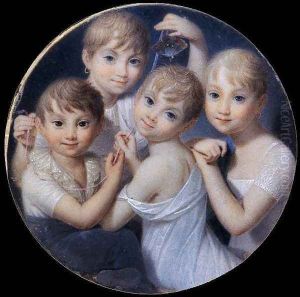Giambattista Gigola Paintings
Giambattista Gigola was an Italian painter active during the late 18th and early 19th centuries, known primarily for his elegant portrait miniatures and for his works in religious and historical themes. Born in 1767 in Brescia, a city in the Lombardy region of Italy, Gigola was caught in the cultural transitions of his time that were marked by the fading of the Rococo style and the rise of Neoclassicism.
Gigola received his early art education in his hometown before moving to Milan, where he was influenced by the Neoclassical movement that was predominant in Europe at the time. This was a period in which artists looked back to the art and philosophy of ancient Greece and Rome for inspiration, often characterized by simplicity, clarity of structure, and a focus on idealized figures and themes.
Throughout his career, Gigola became renowned for his refined technique in miniature painting, a genre that was highly popular among the European courts and the aristocracy of the time. His works often depicted members of the upper class, capturing their likeness with a high level of detail and a delicate use of color. Gigola's miniatures were appreciated for their elegance and charm, as well as for their sophisticated portrayal of fabrics and jewelry, which reflected the wealth and status of his subjects.
Despite the prominence of his portrait miniatures, Gigola's oeuvre also included larger-scale religious and historical paintings, which were commissioned by various churches and private patrons. These works exhibited his ability to handle more complex compositions and narratives, though they are less frequently discussed in art historical literature compared to his miniatures.
Gigola's career spanned the turbulent years of the Napoleonic Wars and the subsequent changes in political power in Italy. These shifts had an impact on the art world, as the patronage system evolved and artists had to navigate the changing tastes and allegiances of their commissioners. Despite these challenges, Gigola maintained a successful practice until his death in 1841.
Giambattista Gigola left behind a legacy as one of the prominent miniature portraitists in Italy during a time of significant artistic and political change. His work provides valuable insight into the styles and social milieu of the era, capturing the likenesses of figures who navigated the complexities of the late 18th and early 19th centuries.
